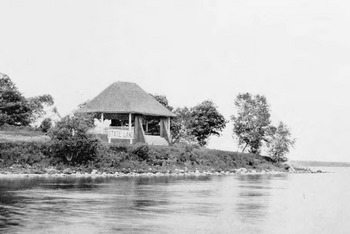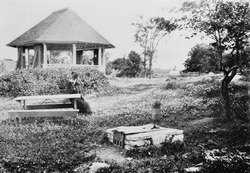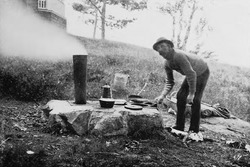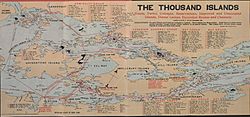St. Lawrence Reservation facts for kids
The St. Lawrence Reservation was a special area created by New York State a long time ago. It was located in the beautiful Thousand Islands region, right along the St. Lawrence River. This reservation was one of the very first times New York State bought land to protect it and let people use it for fun activities.
The original idea was to make it part of a big "international park" with Canada. This park would have protected islands on both sides of the border. While that big international park never fully happened, the lands New York bought are now managed as separate state parks. The islands on the Canadian side are now part of the Thousand Islands National Park.
Contents
Why the St. Lawrence Reservation Was Created
In the late 1800s, the Thousand Islands area became very popular. Many rich people started building huge private homes there. This meant less space for everyone else to enjoy the river. Also, people who loved to fish were upset about illegal fishing. They felt the river's natural beauty and resources were being spoiled.
Because of these problems, some local people and fishermen decided something had to be done. They wanted to protect the land and water on both the American and Canadian sides of the river.
Working Towards an International Park
A group called the Anglers' Association of the St. Lawrence River was a big supporter of protecting the area. They really wanted to keep the river's fishing healthy. This group included important landowners from both countries. In the 1880s, they started asking both the American and Canadian governments to create rules and set aside public lands for everyone to enjoy.
New York State Buys Land
In 1896, New York State officially created the "State Reservation on the St. Lawrence." They said that all parts of the St. Lawrence River within New York, including its islands, would be part of this new park. The job of managing this new reservation went to the New York State Fisheries, Game and Forest Commission. They were in charge of making rules for these state lands.
At first, New York State didn't own any land in this area, which stretched for about 100 miles along the river. So, in 1897, the Commission started buying properties. They had $30,000 to spend. It was a bit tricky because some landowners asked for much more money when they found out the state wanted their land. Also, towns like Ogdensburg and Clayton argued about where the state should build its parks.
By 1898, the state had bought several places for the reservation. These included:
- Burnham's Point
- Cedar Point
- Canoe Point (on Grindstone Island)
- Watterson's Point (on Wellesley Island)
- Mary Island
- Kring's Point
- Cedar Island
- Lotus Island
- De Wolf Point (on Wellesley Island)
Mary Island and Canoe Point were bought in 1897, and the others in 1898. These purchases were some of the earliest times New York State protected land for fun activities. Only the Forest Preserve and Niagara Reservation were protected earlier.
The state wanted these lands to be places where boaters could have picnics and go camping. So, they quickly made improvements. By 1899, most parks had docks for boats and pavilions (shelters). To stop forest fires, cooking stoves were built at most parks for campers to use.
In 1911, the area was officially named the "St. Lawrence Reservation." It also grew to include parts of Lake Ontario near Jefferson County. This included bays like Chaumont Bay and their islands. Long Point was bought in 1913. Later, Grass Point was added, which was the last piece of land for the reservation.
Canada's Role in Protecting Islands
At the same time New York State was buying land, the Canadian government also started protecting islands on their side of the St. Lawrence River. By 1896, Canada had found 11 islands they wanted to protect and develop for recreation.
Canada didn't have to buy most of its islands. An old agreement with the Mississaugas (a First Nations group) meant that Canada already owned many of the St. Lawrence River islands. It wasn't until the 1880s that these islands could be sold to private people. In 1904, Canada officially bought 11 islands to create the St. Lawrence National Park, which is now called Thousand Islands National Park. The fun facilities built on the Canadian islands were similar to those on the American side.
The Parks Today
Even though both countries developed public parks, a formal "international park" never fully happened. The rules for fishing and other things ended up being different in the early 1900s. Also, the United States federal government didn't get involved with the American parks. Even so, New York continued to call the Thousand Islands an "international park" as late as 1929.
In 1932, the parks of the St. Lawrence Reservation were put under the control of a new group called the Thousand Islands State Park Commission. This group started turning the reservation lands into separate state parks. The official definition of the St. Lawrence Reservation was removed from the law in 1963. This was because the lands were no longer managed by the original department.
Today, the parks that were once part of the St. Lawrence Reservation are managed by the Thousand Islands Region of the New York State Office of Parks, Recreation and Historic Preservation. They also manage other state parks along the St. Lawrence River that were added later.





